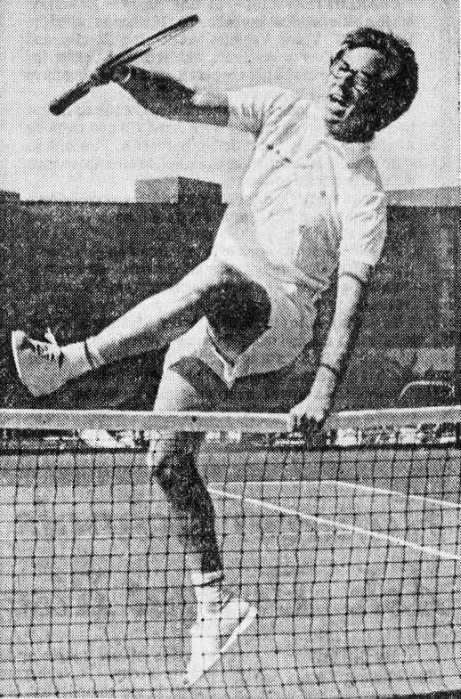On May 9th, 1973, tennis was four days away from what one Los Angeles-area columnist called the sport’s “biggest day ever.” Fans across the United States could watch the World Championship Tennis final match from Dallas–featuring, perhaps, Stan Smith and Ken Rosewall–on NBC. A few hours later, they could tune into CBS and watch 55-year-old Bobby Riggs challenge Margaret Court in the much-hyped “Battle of the Sexes.”
Riggs called it “the match of the century.” He had ballyhooed the date so relentlessly that he might have believed it.
Everyone knew that the Riggs match didn’t really matter, that a contest between a male has-been and a female superstar wouldn’t settle anything. One Wisconsin newspaper urged its readers to watch the WCT final–that would be real tennis. But no matter how big Smith served, or how beautifully 30-somethings Rosewall and Rod Laver continued to play, the Battle of the Sexes was the event on everyone’s lips.
So, with the big day in sight, what was Bobby doing? At home in Newport Beach, he could’ve walked to a half-dozen tennis courts. But he preferred to drive 120 miles into the desert to the La Costa Racquet Club, where his long-time buddy Pancho Segura was the resident pro. The five-foot, eight-inch Riggs–Court was an inch taller–did a bit of running and played a few sets of tennis, preferably for money. When Bud Collins called for an interview, Bobby offered him a match with “two chairs”–Bud could put two chairs anywhere on Riggs’s side of the court to slow him down.
Most of all, the long-ago Wimbledon champ spent his time working the phones. After retiring as a full-time pro two decades earlier, he had tried his hand at promotion. Results were mixed, but never for a lack of effort. Riggs had a minute for anyone who asked.
If you wanted to bet against him, look no further: Bobby had “plenty of side action” on the match, though he questioned the odds out of Las Vegas that made him a 7-5 favorite. He claimed it was a tossup. “She plays like a man, I play like a woman,” he said. “She’s younger and stronger, bigger and faster. She’s got a better serve, a better volley and a better overhead. She’s got me beat in every department except, maybe, thinking, strategy, experience.”
It was true: Riggs’s brain was the only thing that could keep up with his mouth. “He has one of the quickest, most fertile minds I’ve ever seen,” said Bill Talbert, a former US National doubles champion. “His mind is always darting from one thing to another.”
“Half the time,” added Segura, “I don’t know what he is saying.”
Court, for her part, was lying low in San Francisco. She practiced with coach Dennis Van der Meer and got daily treatments on her legs, which had cramped up the week before at Hilton Head.
One reporter, seeking a fresh angle on the most-covered tennis story of the year, called up Richard González, the 45-year-old legend who had had his share of encounters with Riggs. González was busy preparing for a tournament at Caesar’s Palace in Las Vegas, the Alan King Classic. The event was just a week away. Its purse of $150,000 was yet another prize money record for 1973.
Gorgo’s take on the exhibition that was hogging all the publicity? “I couldn’t care less.”
But like everyone else, González had an opinion. “I sort of think Margaret can win it,” he said. “But I still couldn’t care less.”
* * *
This post is part of my series about the 1973 season, Battles, Boycotts, and Breakouts. Keep up with the project by checking the TennisAbstract.com front page, which shows an up-to-date Table of Contents after I post each installment.
You can also subscribe to the blog to receive each new post by email:
